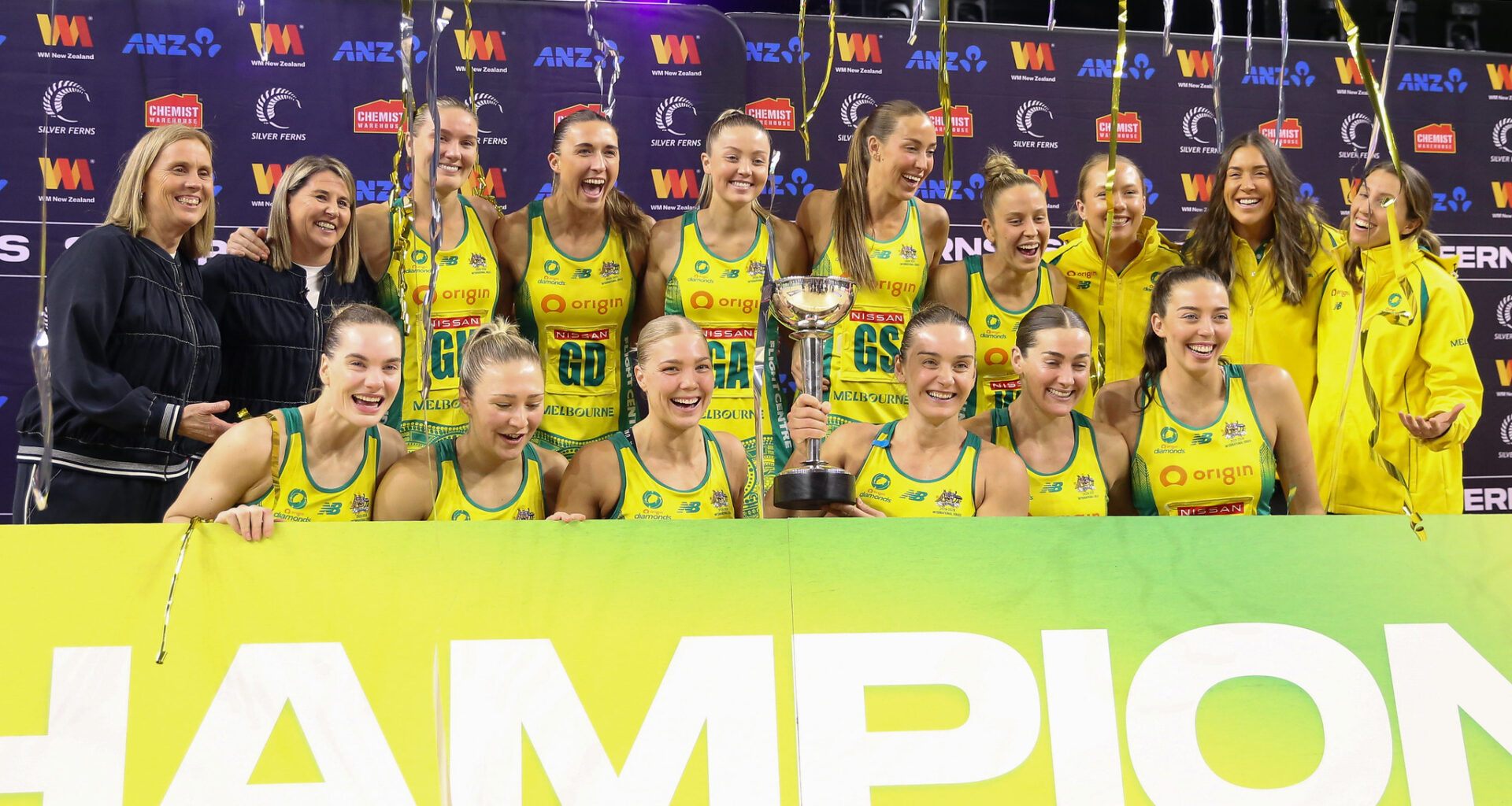Writers: Jenny Sinclair, Ian Harkin, Katrina Nissen
Photographers: Graeme Laughton-Mutu
Cover Image: Graeme Laughton-Mutu
OVERVIEW
The Australian Diamonds have won the 2025 Constellation Cup in dramatic circumstances. Heading into the New Zealand leg of the series with a 2-0 lead, the Diamonds had chances to win both tests, but ultimately fell short. This is becoming a real problem for Australia as they haven’t won a test match on New Zealand soil since 2021. Instead, it was the Silver Ferns, roared on by their home crowds, who gained in confidence and won both tests, in Hamilton and Christchurch, to level the series at 2-2.
This resulted in the first use of Series Decider Time, an initiative introduced last year to break the deadlock in tied series. Teams took a short break after the end of Test 4, then started over again, playing for 14 minutes to decide the 2025 series winner. The Australians were able to control things well, and ended up taking it out 12-11. Despite the win, celebrations were muted from the Diamonds as in the very last second of play, defender Sunday Aryang suffered what appeared to be a serious knee injury. And sadly, it has now been confirmed that Aryang ruptured her ACL in the incident. It is a cruel blow for a player who had an outstanding series and cemented her position as Australia’s top goal defence.
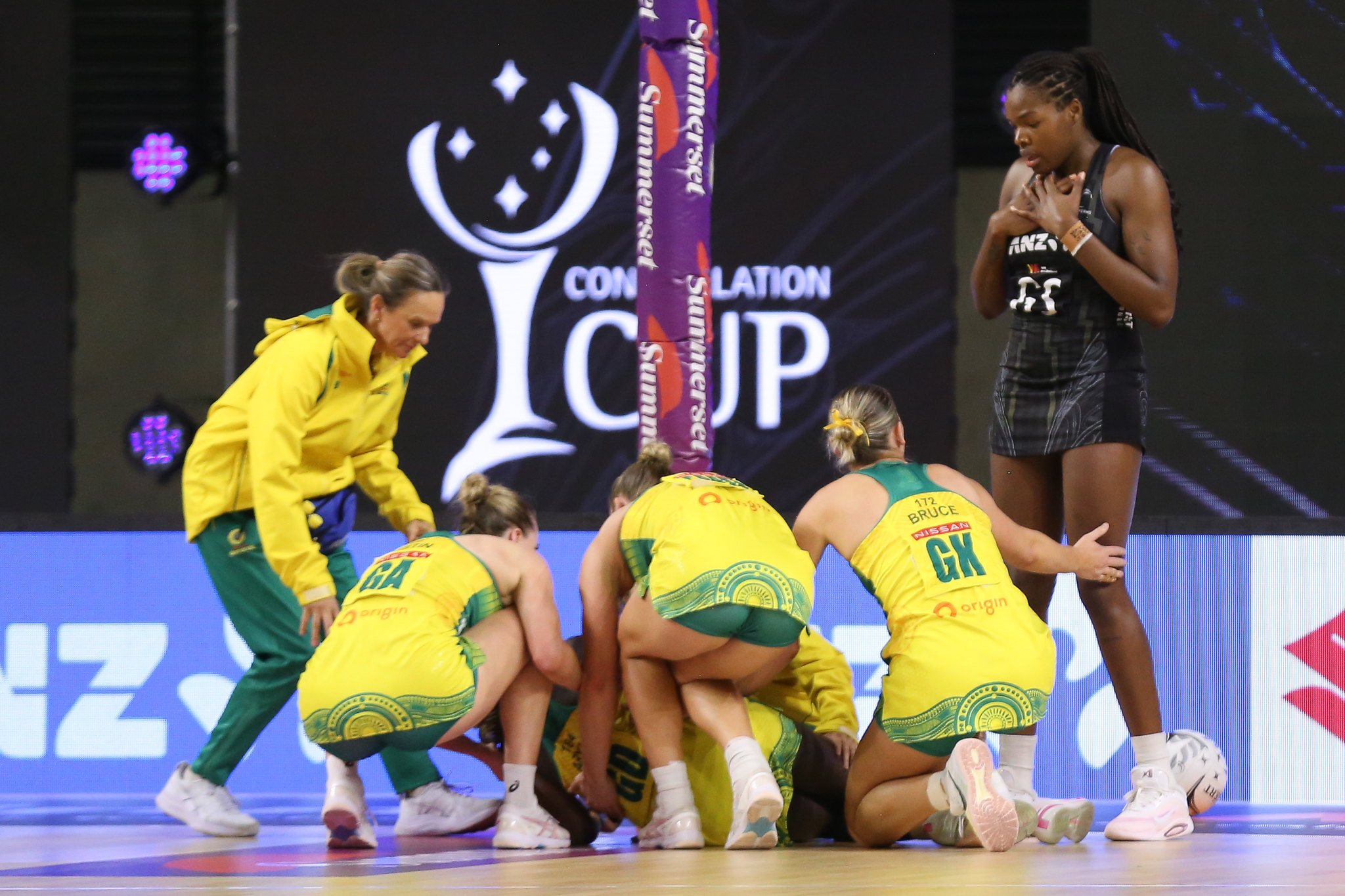
A last second injury to defender Sunday Aryang dampened Australia’s celebration. Image: Graeme Laughton-Mutu
TEST 3 – Hamilton
New Zealand 61 def Australia 52 (13-12, 16-16, 20-11, 12-13)
Staging a 26-goal turnaround in just four days, New Zealand won the third test comfortably to stay alive in the series, heading into the last match. That didn’t appear very likely early on when the Diamonds shot out to a 5-1 lead. But roared on by their home fans, the Silver Ferns were able to take the lead late in the first quarter, and from there, they never relinquished it. With only one the difference at half time, it was the third quarter where the game was blown wide open. The Ferns won it by nine goals and that was the final margin. For the Australians, it was another disappointment in New Zealand, their ninth straight loss there.
The difference between this test and the previous two was stark. Suddenly, it was the Diamonds making the fundamental mistakes. They had as many turnovers in Test three as in the first two tests combined. The New Zealand defence, led by captain Karin Burger (four gains) forced the Australian attack end into error, with 10 turnovers coming from the starting shooters, Kiera Austin (6), and Sophie Garbin (4). On several occasions, the Australians hesitated when in shooting positions and the resulting extra pass proved costly.
The uncertainty was also there among the feeders, as the New Zealand defence had most of the attacking options covered. Liz Watson finished with 18 assists, but wasn’t nearly as effective as she had been in the second test. The Diamonds only scored from 67% of their centre passes in this game, compared to over 80% in both Australian tests. And the Silver Ferns were able to capitalise regularly at the other end of the court. Despite being costly herself in terms of turnovers, Grace Nweke proved impossible to stop for the Australian defence who were on the wrong end of the umpires’ whistle.
Australia could only come up with six gains for the match, as pinpoint passes came into Nweke regularly, leaving them with little chance. Maddy Gordon finished with 24 assists, including 10 in the decisive third quarter when all the damage was done. To complement a strong defensive game, Kate Heffernan also came up with 12 assists, including several long bombs while playing wing defence.
Player of the Match: Karin Burger (New Zealand)
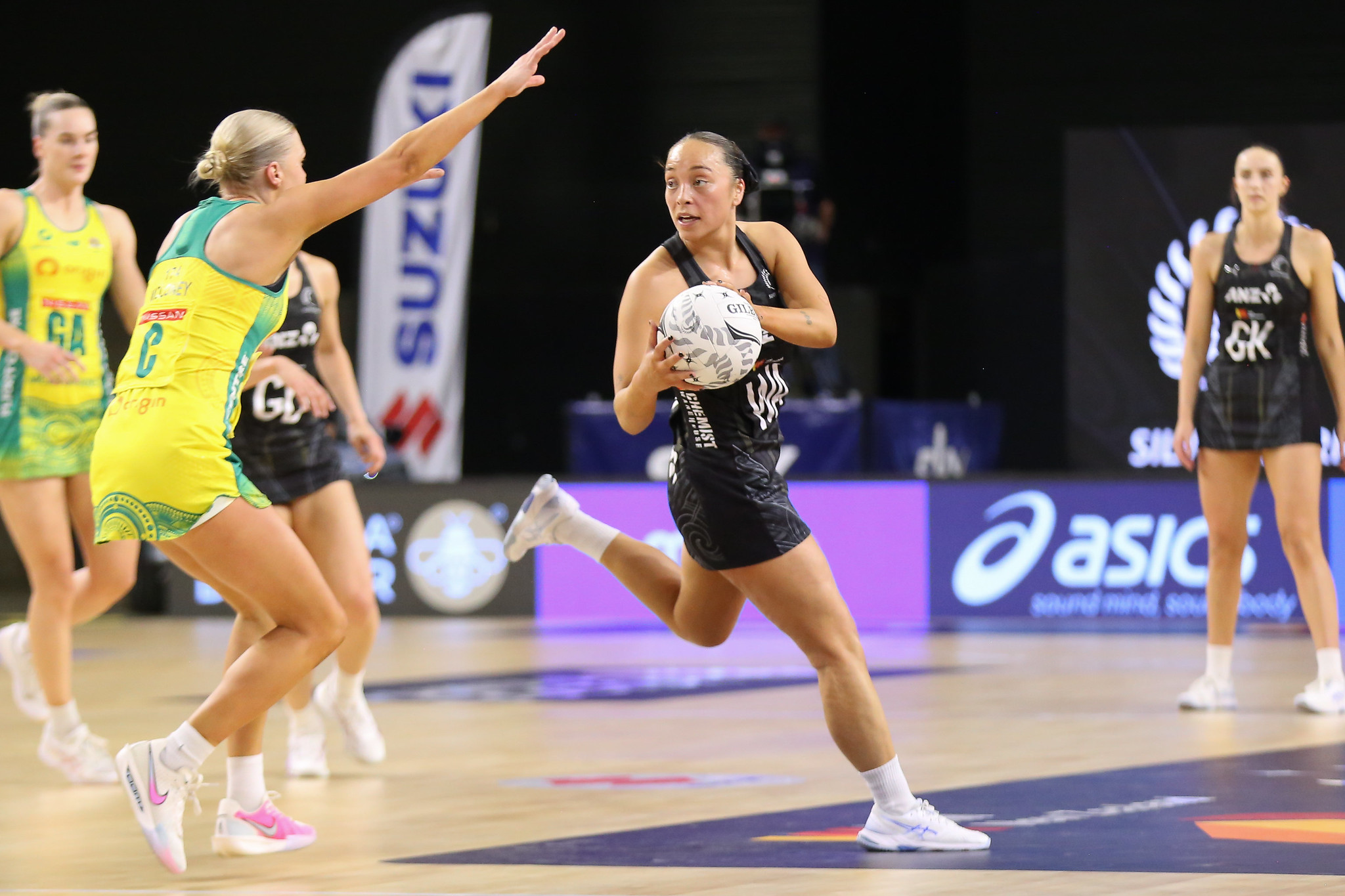
Mila Reuelu-Buchanan made a strong return to the international stage after a knee injury kept her off the court in 2024. Image: Graeme Laughton-Mutu
TEST 4 – Christchurch
New Zealand 62 def Australia 57 (12-17, 15-16, 16-13, 19-11)
For the tenth time in a row, the Silver Ferns have come out on top of Australia in New Zealand. The Diamonds started the match strongly but faded, while it was the complete opposite for the Silver Ferns. Australia went to the first break up 17-12, then they increased their lead by one in a tight second quarter to go in at half time ahead 33-27. It was in the second half where the Silver Ferns started to grow in confidence, and the vocal Christchurch crowd got right behind them. The home team won the third quarter by three, and then it was domination in the final quarter, winning it 19-11 to take control of the match.
For New Zealand, this was Grace Nweke’s best match of the whole series. The defence simply had no answer to her, and unlike previous tests, she was almost faultless in this game, missing just three attempts and not giving up a single general play turnover. Her opponent for most of the match, Courtney Bruce, finished with five gains, but she was repeatedly beaten in the air by Nweke. The player doing most of the feeding was Maddy Gordon, who finished with 26 assists, half of these coming in a remarkable last quarter. Gordon was ably assisted in the midcourt by Kate Heffernan (12 assists and two gains).
For the Diamonds, Kate Moloney (21 assists and five pickups) had another excellent game at centre, while Sunday Aryang tried her heart out in defence. Where the match turned, was in the Australian shooting circle. Sophie Garbin and Kiera Austin had started well, and were on top at half time. The introduction of Catherine Hall (2 gains) at goal defence to partner Kelly Jackson (5 gains), proved a winning move. Together, they were able to put pressure on the shot and get hands in to disrupt the passes in and around the circle. Due to the defensive pressure, the Australian feeders were struggling to find Garbin, and Austin took a few poor options due to indecision. Australia’s shooting percentage was well down on New Zealand’s, and they were only able to take two rebounds for the match.
The game started to get away from Australia quickly in the last quarter. Numerous changes were made to try to rectify things, but with the Silver Ferns appearing headed for victory, it seemed that Stacey Marinkovich then made the decision to rest some of her players in readiness for the extra 14 minutes of action that was about to come up.
Player of the Match: Maddy Gordon (New Zealand)
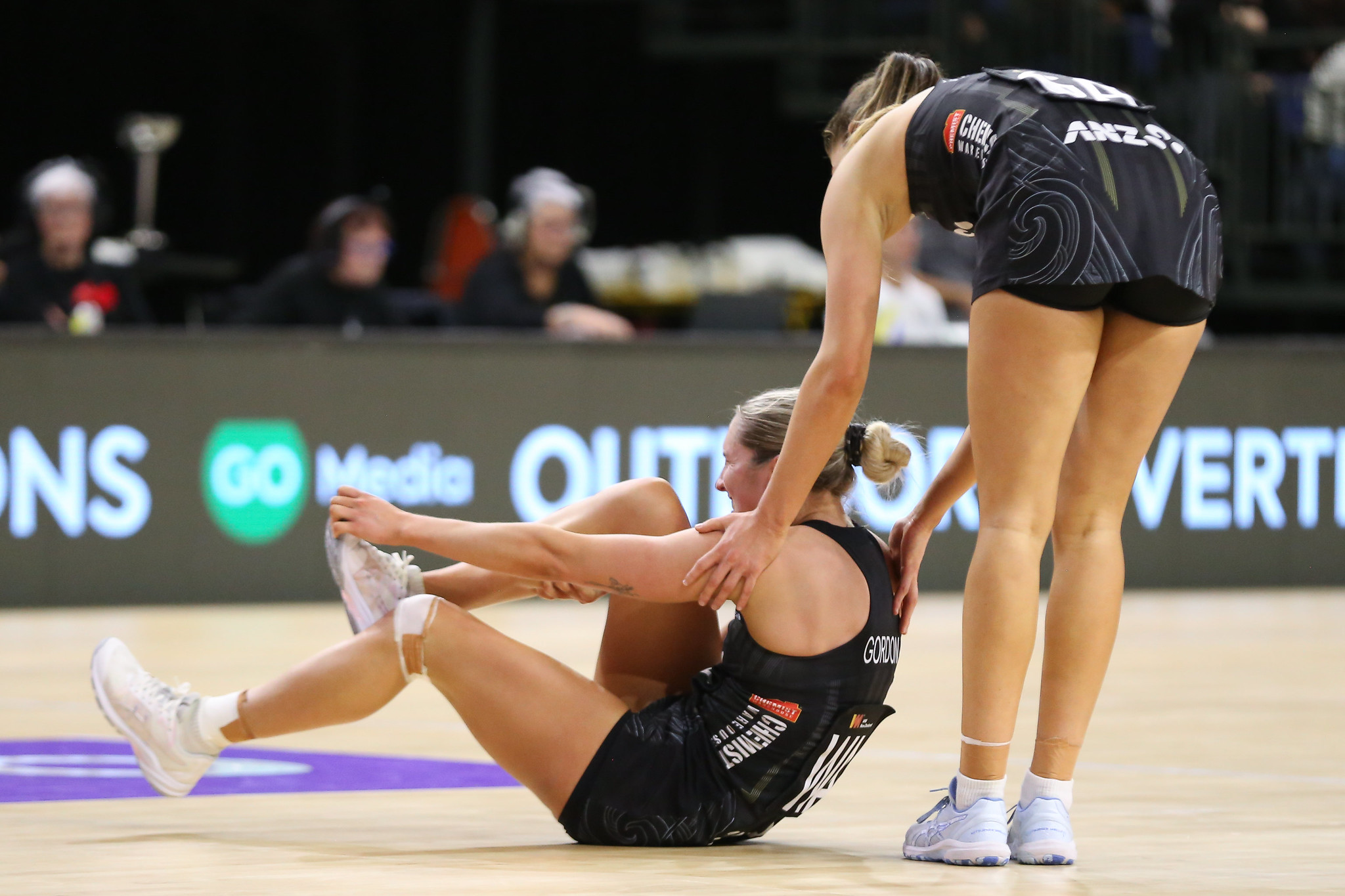
After playing 126 minutes across games 3 and 4, Maddy Gordon was unable to finish the Series Decider due to calf cramps. Image: Graeme Laughton-Mutu
SERIES DECIDER
Australia 12 def New Zealand 11 (7-5, 5-6)
Heading into this extra period of 14 minutes, it could be assumed that the Silver Ferns were riding high on confidence, but the two teams were given 14 minutes to recover after the completion of Test 4. This would have been valuable time for the Diamonds to regather their thoughts. Things looked ominous for them however as they were down 3-0 early, bfeore a couple of errors in attack from the Ferns soon had the game going goal for goal. And then possibly a turning point, as Maddy Gordon had to leave the court through cramp. The Diamonds surged ahead with five straight goals either side of half time to lead 9-5, before they too came unstuck.
With 87 seconds left to play, the scores were tied at 11 apiece. Then we saw a game of keepings-off as the Diamonds somehow managed to maintain possession under great pressure until the death. Sophie Garbin scored their 12th goal with just four seconds remaining, and then a last-ditch hail mary pass from New Zealand was unsuccessful. In the process, unfortunately Sunday Aryang, who had come up with two crucial intercepts during the 14 minutes, was badly injured. She lay on the court clutching her knee in agony, leading to very subdued celebrations from the other Diamonds players.
Australia wins the Constellation Cup.
Player of the Series: Karin Burger (New Zealand)
Both sides said playing a series decider after a hard fought 60-mins was an ‘interesting’ way to decide a series.
Liz Watson said, “We just knuckled in during these last 14 minutes to get the job done. It is a really strange win. But we are proud, and that was our goal from day one, to take that cup home back to Australia.”
Karin Burger said, “I think it was a really great experience, especially for the inexperienced girls, to play under that pressure. So it puts us in a good position going forward. But I am obviously gutted that we couldn’t get that last point.”
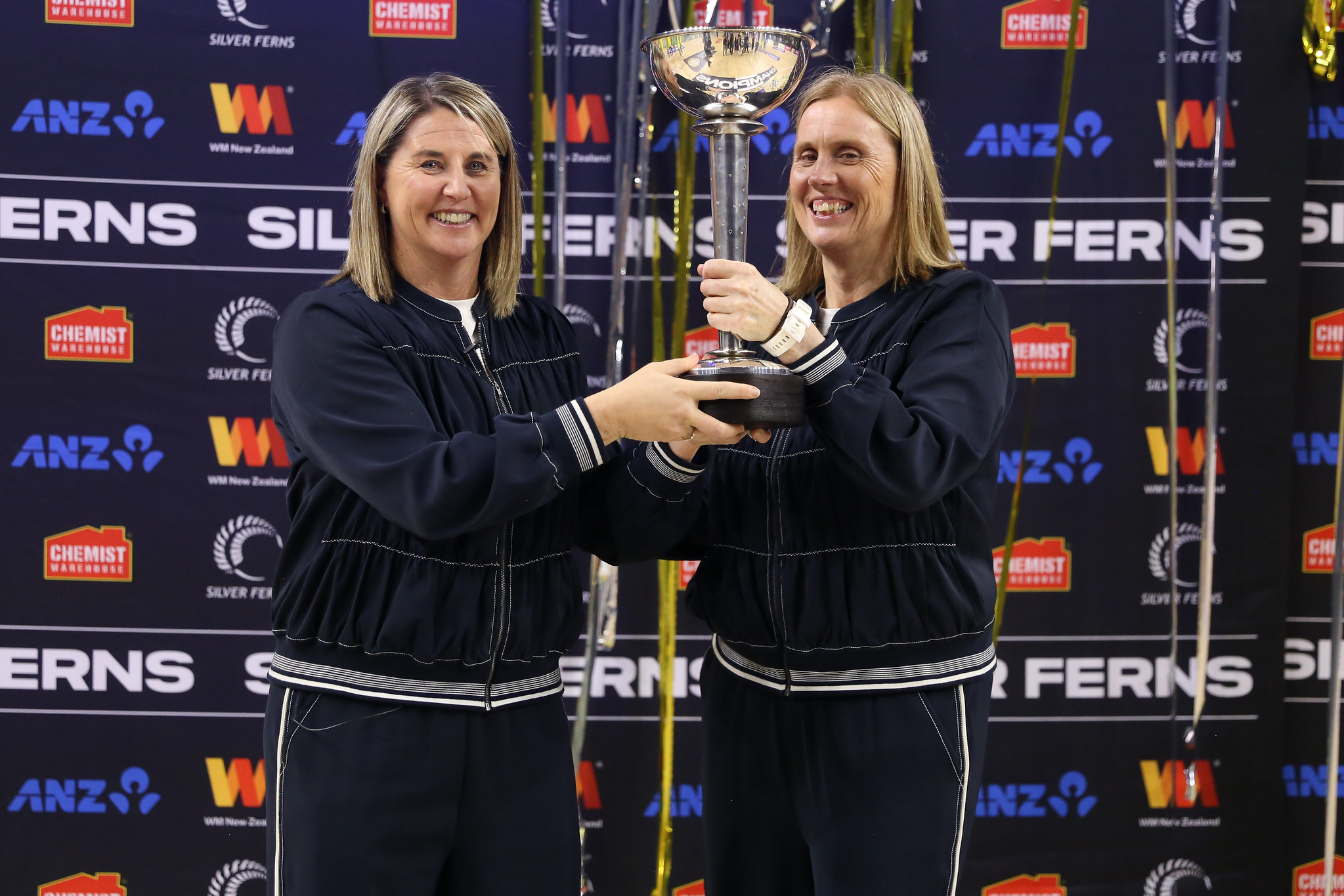
Australian Diamonds Constellation Cup champion coaches, Stacey Marinkovich and Nicole Richardson. Image: Graeme Laughton-Mutu
STRENGTHSDiamonds
It’s incredibly sad to say in light of the injury that will keep Sunday Aryang out of netball for some time, but her growth at goal defence has been phenomenal in the last year. One of the least penalised defenders in the business, Aryang can switch up her game from a close marking style, to floating off the body and back into the circle to help out Courtney Bruce. Aryang finished with five gains across the last two games, and would have gone close to player of the series.
Speaking post match, Diamonds coach Stacey Marinkovich complimented Aryang’s growth across the series. “I thought Sunday had a sensational series. I thought she came in, and she has done an incredible amount of work.”
Along with Jamie Lee-Price, the duo acted as terrific ball carriers in attack. While some defenders aren’t known for their ball security, both were regular options on the centre pass, or transitioning the ball through court when attackers were stuck for options.
Also of merit is the Diamonds’ capacity to generally keep their turnover rate down. Playing a clinical, possession style brand, Australia averaged just 13 turnovers per game across the series, despite a blowout of 21 in Test 3. And for a midcourt that handles the ball a lot, that’s pretty remarkable.
Kate Moloney finished the Constellation cup with 62 goal assists, including 21 in the final test. These are impressive numbers for a player who often plays second fiddle in attack to Liz Watson. At times in this series, she was able to step up when Watson was being kept quiet. If there’s one thing Moloney is renowned for, it’s her hustle, and the pickup queen collected an incredible eight pickups during the New Zealand leg of the series.
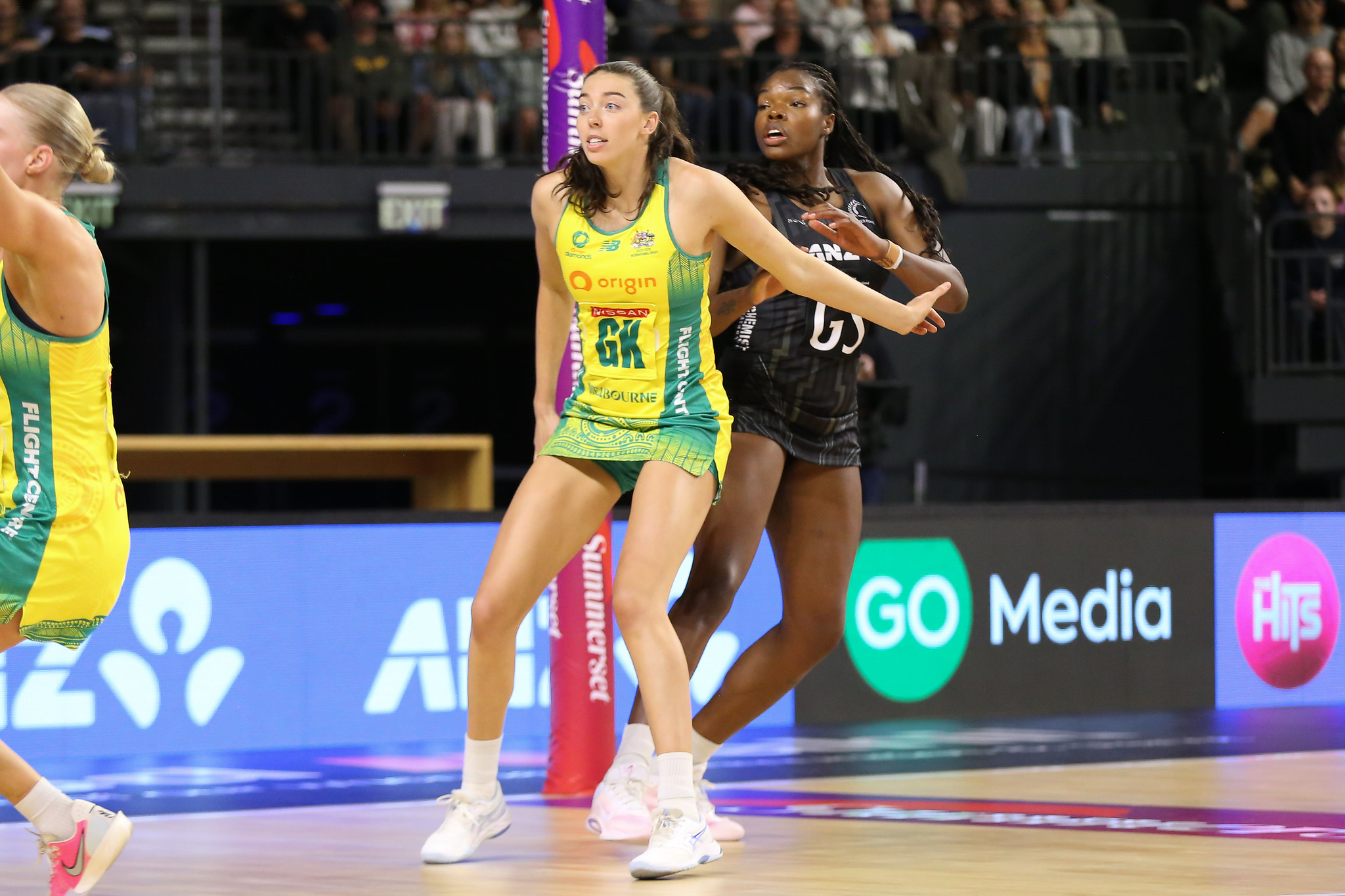
Ash Ervin made two short cameo appearances in game 4 for Australia. Image: Graeme Laughton-Mutu
Silver Ferns
If there’s one criticism of Dame Noeline Taurua, it’s that she perhaps sacrificed depth for wins in recent years. As a result there’s been limited alternatives to Grace Nweke, Ameliaranne Ekenasio, Kelly Jackson, Karin Burger and Maddy Gordon in particular. And while the Ferns still relied heavily on these players – bar the absent Ekenasio – in this series, it was terrific to see interim coach Yvette McCausland-Durie start to look at alternatives in most of these positions.
Post-match, McCausland-Durie acknowledged the growth of the youngster coming through. “I am incredibly proud. We have learnt a lot over the last two weeks about how much depth we do have. And these last two games, having that courage to put those players out there and run the combinations and mix it up and trust. I’m proud that they support each other, and no matter what combination came on, they worked really hard to connect with each other. The desire was there. The intent was there. But we ran out of time. That is sport.”
The available goal attack options are still highly inexperienced, but in Catherine Hall, a defensive star of the future has been revealed. The 191cm specialist goal keeper made cameos mainly at goal defence, and had a strong impact during her time on court. Between her and Jackson’s long arms, the Australian shooters really struggled for impact on the scoreboard.
Burger even acknowledges that the future of the Ferns defensive circle may look different. Post match, she said, “Each time she stepped out there, she showed what she could do. That size when she is in there with Kelly is a complete change-up from when I am in there. She plays to her strengths and her power. And with a bit more time together in that circle, I am sure they will be lethal. I am also so proud of how calm and collected she was. I think the future for her is very bright.”
Bringing Hall on at goal defence allowed the Silver Ferns to move Burger, Kate Heffernan and Maddy Gordon forward, with Gordon clearly their best option at wing attack. Alternatively, Kimiora Poi slotted in nicely at centre, allowing the back three to remain in their usual positions. It’s been a while since the Silver Ferns had some credible depth, so it’s refreshing to see it unfurl.
Maddy Gordon was like two different players during this series. In the Australian leg, she was kept relatively quiet as the Ferns struggled on the scoreboard. But she dominated in New Zealand, finishing with 50 assists in the two tests. She was simply everywhere and led the midcourt well. Her pinpoint passes to Nweke proved impossible to stop.
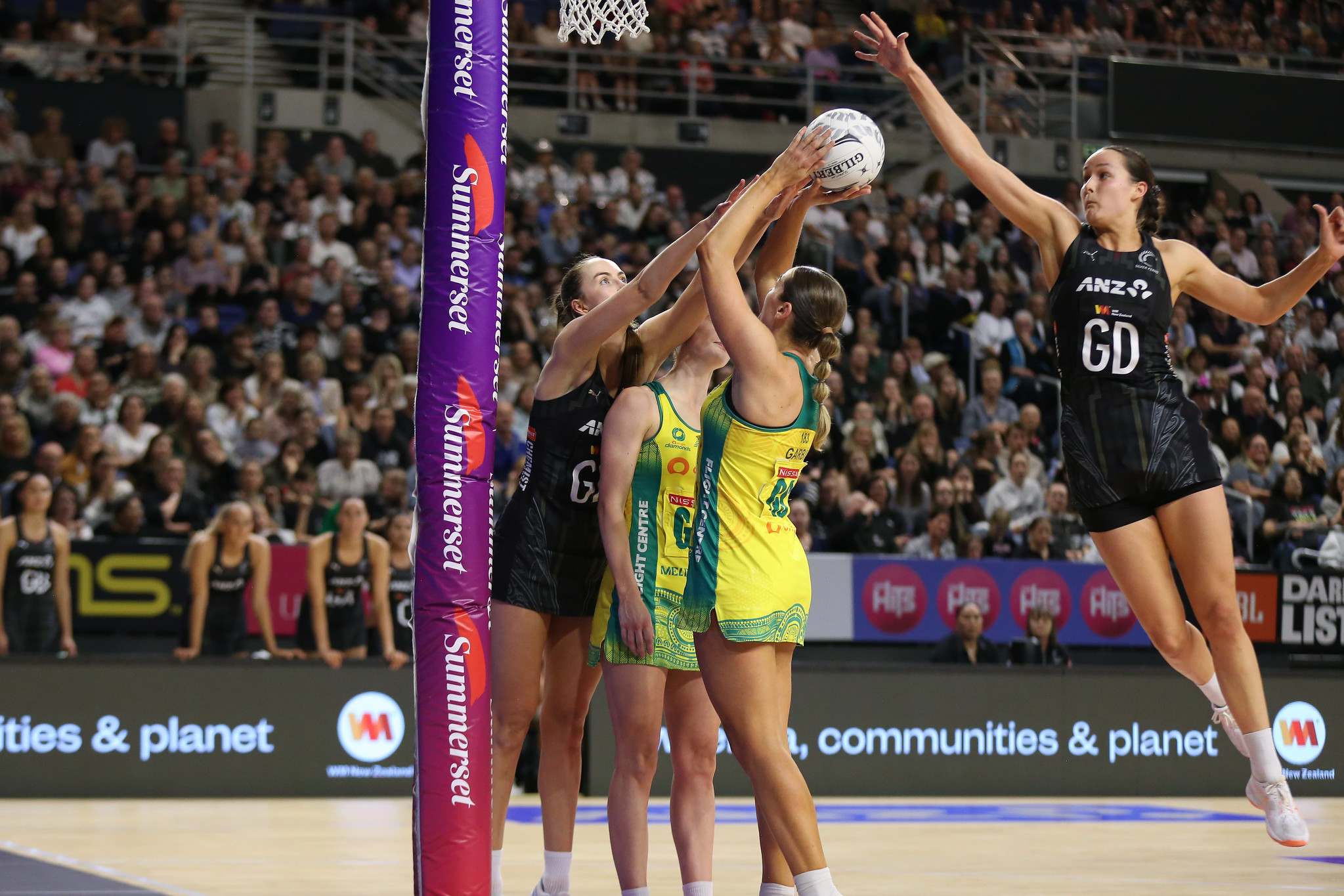
The long arms of Catherine Hall (GD) and Kelly Jackson (GK) caused headaches for the Diamonds shooters. Image: Graeme Laughton-Mutu
CHALLENGESDiamonds
Inconsistency continues to plague the Diamonds in New Zealand, having lost their last ten matches there. They lost Tests 3 and 4 by nine and five goals respectively, although went on to record a one point win in the extra time decider.
In both tests and the decider, it was a late game fade out that cost the Diamonds. In the third test, they lost the third quarter 20-11, the fourth test they lost the fourth quarter 19-11, while they also lost the second half of the decider by one point.
Also of note was their team statistics with several of them being far below the Diamonds usually lofty standards in both matches. In test 3 their centre pass conversion rate sat at just 67% and their turnover to goal rate at 57%. In test 4, it was their gain to goal rate that was just 50%, and their turnover to goal rate at 63%.
Shooting accuracy was also well down in Test 4 at just 81%, with the Australian shooters spooked by the long arms of Kelly Jackson and Catherine Hall. Goal attack options Kiera Austin and Georgie Horjus were particularly vulnerable, Austin because of her low release shot and longer range attempts, and Horjus because of her height. There’s work to be done with technique, whether it’s the release point or becoming more comfortable with a sideways or backways step to avoid their arms.
With shooting accuracy a big factor in this series, this meant that rebounding was doubly important, and this is where the Diamonds fell down in the final two tests. They didn’t manage to pick up a single defensive rebound, and were in fact outrebounded 15-4 during the 2 matches.
Perhaps the biggest point of difference between the Australian and New Zealand legs of the tour, was the Diamonds’ struggles to penetrate the New Zealand zone, which had been conspicuous by its absence earlier in the series. At times the Australian attacking unit looked panicked as they tried to find options, and picked up offensive penalties as they pushed into spaces that didn’t exist.
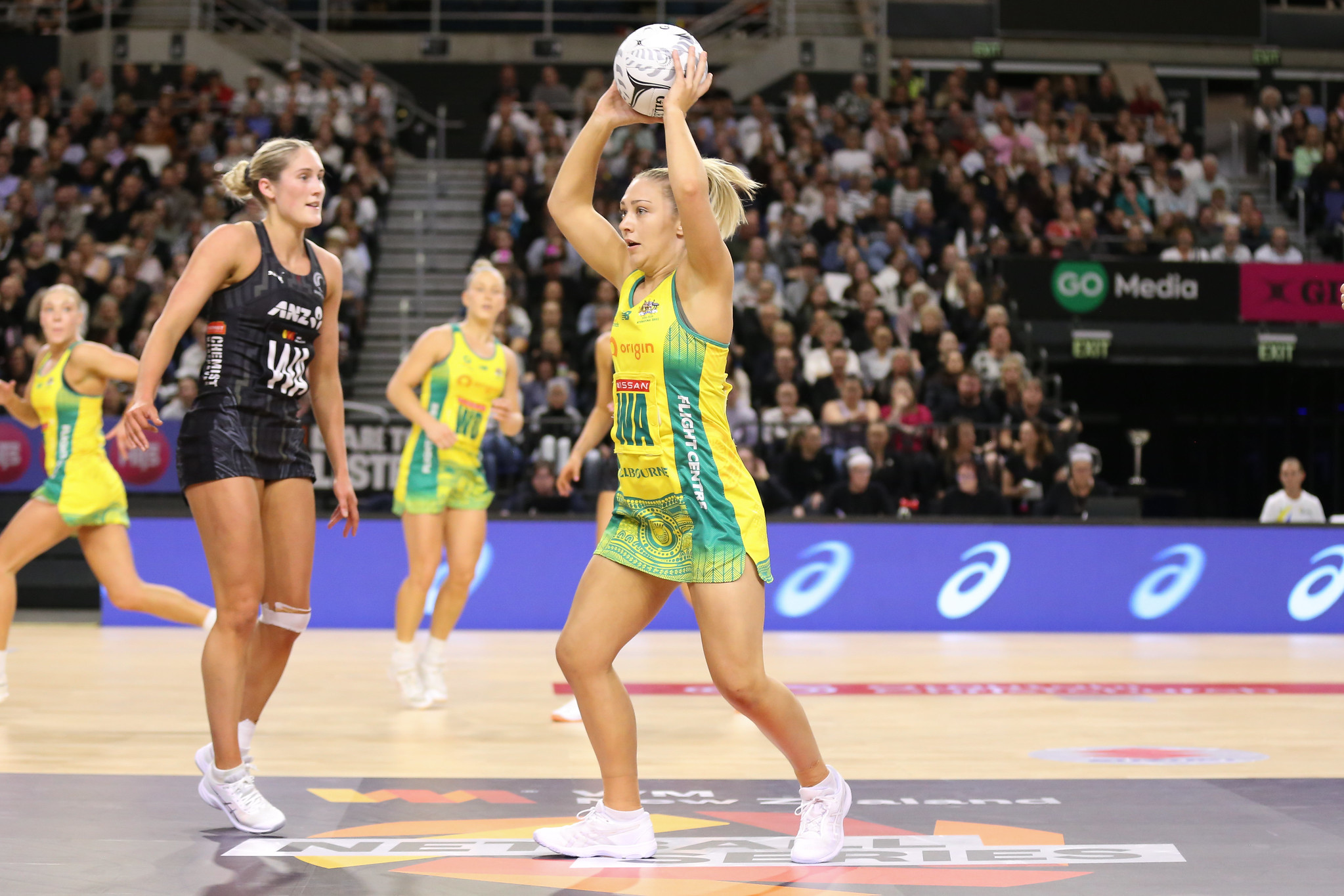
Has Georgie Horjus done enough to secure a Commonwealth Games invite? Image: Graeme Laughton-Mutu
Silver Ferns
Grace Nweke is both the Silver Ferns greatest strength and biggest weakness. Strength due to her incredible athleticism and accuracy – she shot at 96% and 95% across the last two tests. Weakness because she played all bar one minute of the four test matches, and what happens if she is ill or injured? Not only does the bulk of their game plan revolve around the high bomb into Nweke, but both Amelia Walmsley and Martina Salmon are inexperienced and desperately short of court time at this level. Hopefully both will be given opportunities in the Northern Hemisphere tour.
Post-match, McCausland-Durie admitted that the Silver Ferns don’t really have an alternate goal shooter and as such they are playing GS’s out of position. “There was a lot of growth. And, more importantly, they [the three players rotated through GA] have now found what strengths they bring and their points of difference. They are, technically, apart from Georgia, goal shoots, but that spot is largely sewn up. So, they have worked really hard to bring their variation and, I think, the thing I have really loved about the goal attacks is that they have supported each other. They are happy when their mate goes on and they have listened and learned, and I am really proud of that.”
General play turnovers are an area that the Silver Ferns could also tighten up on. With Nweke’s accuracy and ability to grab the rebound, the Ferns only gave up one missed goal turnover during the two tests, but it was the general play turnovers that hurt them. After being level pegging with Australia in Test 3 on 21 apiece, in Test 4, they committed 17 to the Diamonds’ 13. Reducing this stat would heavily impact the scoreboard. It was their more experienced players Karin Burger, Maddy Gordon and Nweke who were the main offenders. The trio gave away 23 in these two tests combined.
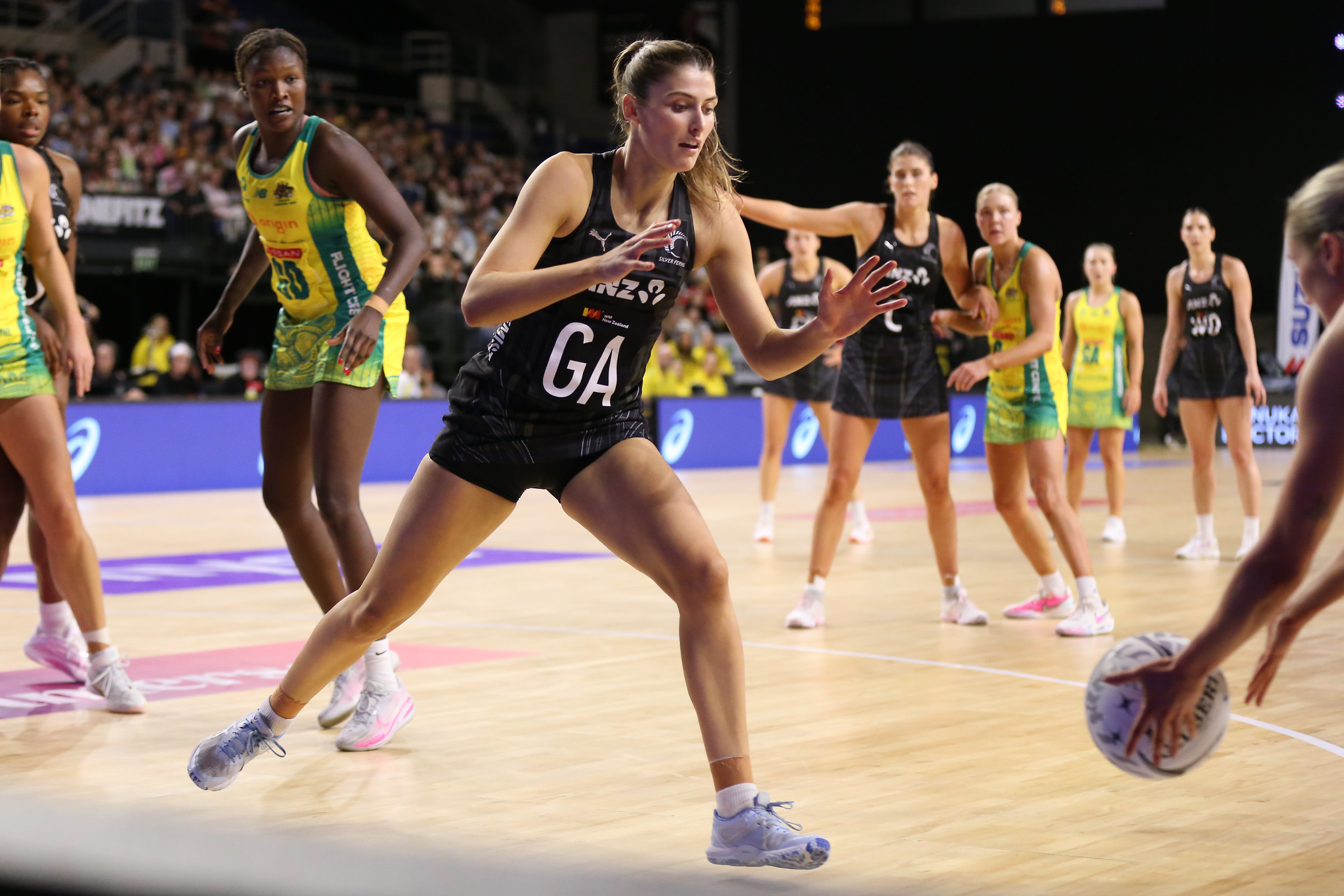
New Zealand trialed three goal attacks across games 3 and 4. Georgia Heffernan was the most effective. Image: Graeme Laughton-Mutu
KEY STATS
So, why is it that home teams have such a dominant record in the Constellation Cup? It’s a strange phenomenon. In the last five years, each nation has won just one test away from home. It seems that when these two teams get a confidence lift from their home fans, they get on such a roll that the opposition simply can’t stop them. That was certainly the case in this series.
During all four tests, the winning team has outscored their opposition in the second half by 15, 15, 8, and 11 goals respectively. But in each case, it has been one quarter in particular which made all the difference. In the third test, it was the third quarter where the game was blown wide open as the Silver Ferns won it 20-11, while in the fourth test, it was the last quarter where New Zealand dominated to the tune of 19-11. If we go back to the Australian leg of the series, we can see it’s a pattern of the home team getting right on top of the away team in just one decisive 15 minute period.
Test 1: Diamonds won Q4 by 13. Final margin 17
Test 2: Diamonds won Q3 by 12. Final margin 17
Test 3: Silver Ferns won Q3 by 9. Final margin 9
Test 4: Silver Ferns won Q4 by 8. Final margin 5
Stats from the final two tests:
Shooting: NZ 123/133 (92%) v AUS 109/129 (84%)
Assists: NZ 114 (Gordon 50) v AUS 99 (Watson 31)
Rebounds: NZ 15 (Nweke 7) v AUS 4 (Garbin 3)
Gains: NZ 21 (Jackson 7) v AUS 16 (Bruce 6)
Intercepts: NZ 7 (Burger 4) v AUS 10 (Aryang 4)
Penalties: NZ 99 (Jackson 24) v AUS 122 (Bruce 27)
Turnovers: NZ 38 (Burger 10) v AUS 34 (Austin 10)
Constellation Cup – combined stats from all four tests
Shooting: AUS 246/291 (85%) v NZ 226/251 (90%)
Assists: AUS 219 (Watson 70) v NZ 203 (Gordon 69)
Rebounds: NZ 30 (Nweke 16) v AUS 22 (Garbin 12)
Gains: AUS 34 (Bruce 12) v NZ 33 (Burger, Jackson 11)
Intercepts: AUS 21 (Bruce 6) v NZ 13 (Burger 7)
Penalties: AUS 230 (Bruce 57) v NZ 239 (Jackson 57)
Turnovers: AUS 53 (Austin 17) v NZ 74 (Burger, Gordon 14)

